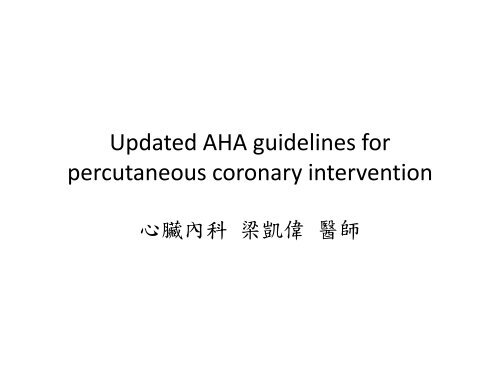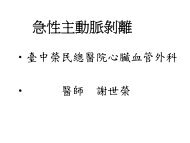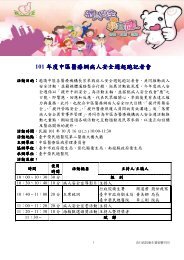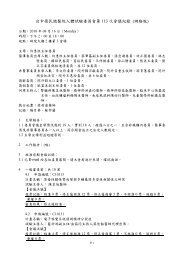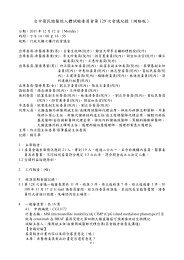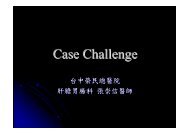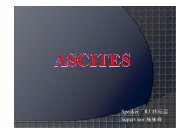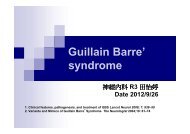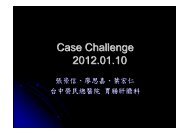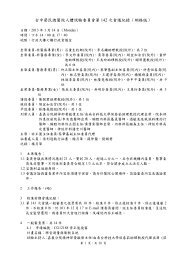Updated AHA guidelines for percutaneous coronary intervention
Updated AHA guidelines for percutaneous coronary intervention
Updated AHA guidelines for percutaneous coronary intervention
You also want an ePaper? Increase the reach of your titles
YUMPU automatically turns print PDFs into web optimized ePapers that Google loves.
<strong>Updated</strong> <strong>AHA</strong> <strong>guidelines</strong> <strong>for</strong><br />
<strong>percutaneous</strong> <strong>coronary</strong> <strong>intervention</strong><br />
心 臟 內 科 梁 凱 偉 醫 師
<strong>AHA</strong> <strong>guidelines</strong><br />
• Updates <strong>for</strong> <strong>percutaneous</strong> <strong>coronary</strong><br />
<strong>intervention</strong> (PCI) in 2011<br />
• Updates <strong>for</strong> non-ST elevation myocardial<br />
infarction (NSTEMI) and unstable angina in<br />
2011 and 2012<br />
• Updates <strong>for</strong> ST-elevation myocardial infarction<br />
(STEMI) in 2007, 2009 and 2011.
Outlines<br />
• Updates <strong>for</strong> revascularization strategies to<br />
improve survival<br />
• Updates <strong>for</strong> management of STEMI<br />
• Newer recommendations <strong>for</strong> PCI- related<br />
devices and pharmacology
SYNTAX score and STS score<br />
• Class IIa<br />
• 1. Calculation of the STS (Society of Thoracic<br />
Surgeons and SYNTAX (Synergy between<br />
Percutaneous Coronary Intervention with<br />
TAXUS and Cardiac Surgery) scores is<br />
reasonable in patients with unprotected left<br />
main and complex CAD.
On-line STS score calculator<br />
http://riskcalc.sts.org/STSWebRiskCalc273/de.<br />
aspx
On-line STS score calculator<br />
Procedure Name Isolated CABG<br />
Risk of Mortality 12.355%<br />
Morbidity or<br />
Mortality<br />
Long Length of<br />
Stay<br />
Short Length of<br />
Stay<br />
Permanent<br />
Stroke<br />
Prolonged<br />
Ventilation<br />
61.422%<br />
39.416%<br />
4.513%<br />
5.184%<br />
63.428%<br />
DSW Infection 1.057%<br />
Renal Failure<br />
N/A<br />
Reoperation 22.205%<br />
http://riskcalc.sts.org/STSWebRiskCalc273/de.<br />
aspx
Syntax score
Syntax score- example<br />
Euro<strong>intervention</strong> 2005;1:219
SYNTAX trial: synergy between PCI with Taxus vs. CABG in triple<br />
vessel disease or LM Outcome: death, MI, stroke, repeat<br />
revascularization: 1800 patients, randomized control trial<br />
Serruys PW et al N Engl J Med 2009;360:961
Inferior PCI outcomes <strong>for</strong> triple vessel or LM in<br />
High Syntax score group: one year data<br />
Serruys PW et al N Engl J Med 2009;360:961
SYNTAX trial: 3-year data<br />
death/stroke/MI CABG 12.0 vs. PCI 14.1%, P = 0.21)<br />
MI rate:. CABG 3.6% vs. DES 7.1% , p=0.007<br />
Repeat revascularization: CABG 10.7% vs. DES 19.7% , p
Unprotected left main<br />
• CABG: class I indication
Unprotected left main<br />
• IIa—For stable ischemic heart disease, PCI<br />
when both of the following are present:<br />
• # Anatomic with a low risk of PCI complications<br />
and a good long-term outcome (eg, a low<br />
SYNTAX score ≤ 22, ostial or trunk left main<br />
CAD)<br />
• # increased risk of adverse surgical outcomes<br />
(eg, STS-predicted operative mortality ≥ 5%)
Unprotected left main<br />
• IIb—For stable ischemic heart disease, PCI when<br />
both of the following are present:<br />
• # Anatomy with a low to intermediate risk of<br />
PCI complications and an intermediate to high<br />
likelihood of good long-term outcome (eg, lowintermediate<br />
SYNTAX score < 33, bifurcation left<br />
main CAD)<br />
• # increased risk of surgical outcomes (eg,<br />
moderate-severe COPD, prior stroke, or prior<br />
cardiac surgery; STS-predicted risk of operative<br />
mortality > 2%)
Unprotected left main<br />
• IIa—For UA/NSTEMI if not a CABG candidate<br />
• IIa—For STEMI when distal <strong>coronary</strong> flow is<br />
TIMI flow < grade 3 and PCI can be per<strong>for</strong>med<br />
more rapidly and safely than CABG
Contrast-Induced Acute Kidney Injury<br />
• Class I<br />
• 1. Patients undergoing cardiac catheterization<br />
with contrast media should receive adequate<br />
preparatory hydration.<br />
• 3. In patients with CKD (creatinine clearance<br />
Adequate hydration<br />
• Isotonic saline (normal saline)<br />
• 1 to 1.5 ml/Kg/hour<br />
• 3-12 hours be<strong>for</strong>e the procedure,<br />
• and 6-24 hour after the procedure.
Contrast-Induced Acute Kidney Injury<br />
• III: NO BENEFIT<br />
• 1. Administration of N-acetyl-L-cysteine is not<br />
useful <strong>for</strong> the prevention of contrast-induced<br />
acute kidney injury.
• Class IIa<br />
Vascular Access<br />
• 1. The use of radial artery access can be useful<br />
to decrease access site complications
Revascularization Be<strong>for</strong>e Noncardiac<br />
Surgery<br />
• Class III: HARM<br />
• 1. Routine prophylactic <strong>coronary</strong><br />
revascularization should not be per<strong>for</strong>med in<br />
patients with stable CAD be<strong>for</strong>e non-cardiac<br />
surgery.<br />
• 2. Elective non-cardiac surgery should not be<br />
per<strong>for</strong>med in the 4 to 6 weeks after balloon<br />
angioplasty or BMS implantation or the 12<br />
months after DES implantation
Outlines<br />
• Updates <strong>for</strong> revascularization strategies to<br />
improve survival<br />
• Updates <strong>for</strong> management of STEMI<br />
• Newer recommendations <strong>for</strong> PCI- related<br />
devices and pharmacology
Primary PCI of the Infarct Artery<br />
• 1. Primary PCI should be per<strong>for</strong>med in patients<br />
within 12 hours of onset of STEMI.<br />
• 2. Primary PCI should be per<strong>for</strong>med in patients<br />
with STEMI presenting to a hospital with PCI<br />
capability within 90 minutes of first medical<br />
contact<br />
• 3. Primary PCI should be per<strong>for</strong>med in patients<br />
with STEMI presenting to a hospital without PCI<br />
capability within 120 minutes of first medical<br />
contact
Definition of 1 st medical contact
Coronary Angiography Strategies<br />
• Class I<br />
in STEMI<br />
• Patients who are candidates <strong>for</strong> primary PCI<br />
• Patients with severe heart failure or cardiogenic<br />
shock who are suitable candidates <strong>for</strong><br />
revascularization, irrespective of time delay
Coronary Angiography Strategies<br />
• Class IIa<br />
in STEMI<br />
• 1. A strategy of immediate CAG/PCI is reasonable <strong>for</strong><br />
patients with STEMI, a moderate to large area of<br />
myocardium at risk, and evidence of failed fibrinolysis.<br />
• 2. A strategy of CAG/ PCI, 3 to 24 hours after<br />
initiating fibrinolytic therapy in STEMI and evidence<br />
<strong>for</strong> successful fibrinolysis is reasonable
Outlines<br />
• Updates <strong>for</strong> revascularization strategies to<br />
improve survival<br />
• Updates <strong>for</strong> management of STEMI<br />
• Newer recommendations <strong>for</strong> PCI- related<br />
devices and pharmacology
Rotational atherectomy <strong>for</strong> fibrotic or heavily calcified lesions<br />
that might not be crossed by a balloon catheter or adequately<br />
dilated be<strong>for</strong>e stent implantation (class IIa).<br />
Boston Scientific website
Cutting balloon angioplasty <strong>for</strong> avoiding slippage-induced<br />
<strong>coronary</strong> artery trauma during PCI <strong>for</strong> in-stent restenosis or<br />
ostial lesions in side branches (class IIb)
Aspiration thrombectomy is reasonable <strong>for</strong> patients<br />
undergoing primary PCI <strong>for</strong> STEMI (class IIa)
Embolic protection devices should be used during<br />
saphenous vein graft PCI (class I)
Glypoprotein IIb/ IIIa inhibitors use in STEMI<br />
• Class IIa- start treatment with glycoprotein<br />
IIb/IIIa receptor antagonists at the time of<br />
primary PCI in selected patients at cath room<br />
• Class III (no benefit)-routine pre-catheterizaiton use<br />
(ex. At ER, or ambulance), as an upstream therapy <strong>for</strong><br />
pts with STEMI planning <strong>for</strong> primary PCI
Glypoprotein IIb/ IIIa inhibitors use in<br />
NSTEMI/unstable angina<br />
• Class I: In high-risk pts not adequately pretreated<br />
with clopidogrel, it is useful at the<br />
time of PCI to administer a GP IIb/IIIa inhibitor<br />
(ex. high-bolus dose tirofiban) in addition to<br />
heparin<br />
• Class IIa: In high-risk pts, treated with heparin<br />
and adequately pretreated with clopidogrel, it<br />
is reasonable at the time of PCI to administer<br />
a GP IIb/IIIa inhibitor
Choice of 2 nd antiplatelet to be added on aspirin<br />
in UA/NSTEMI (Class I indication)<br />
• Invasive approach be<strong>for</strong>e PCI: clopidogrel, or<br />
ticagrelor or An IV GP IIb/IIIa inhibitor,<br />
• Invasive approach during PCI: during PCI: :<br />
clopidogrel, or ticagrelor or An IV GP IIb/IIIa<br />
inhibitor or prasugrel<br />
• Conservative approach: clopidogrel or<br />
ticagrelor
ADP P2Y 12 receptor blockade<br />
Dullewe et al. Expert Rev. Clin. Pharmacol 5 (3):257; (2012)
Clopidogrel vs. ticagrelor<br />
Montalescot et al. Int J Cardiol 2012
PLATO study design
Ticagrelor vs. Clopidogrel as 2 nd dual antiplatelet agents in<br />
acute <strong>coronary</strong> syndrome (PLATO trial): primary end point:<br />
vascular death or MI or stroke<br />
ticagrelor 9.8% vs. clopidogrel 11.7%, p
Summary<br />
• Updates <strong>for</strong> revascularization strategies to<br />
improve survival- complex CAD and LM<br />
• Updates <strong>for</strong> management of STEMI<br />
• Newer recommendations <strong>for</strong> PCI- related<br />
devices and pharmacology


